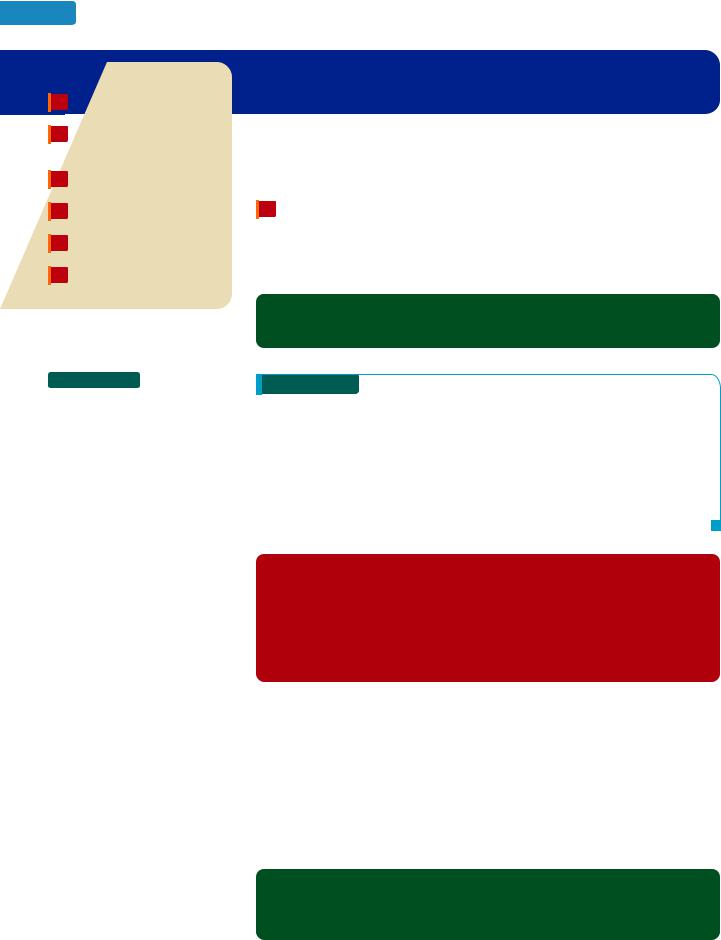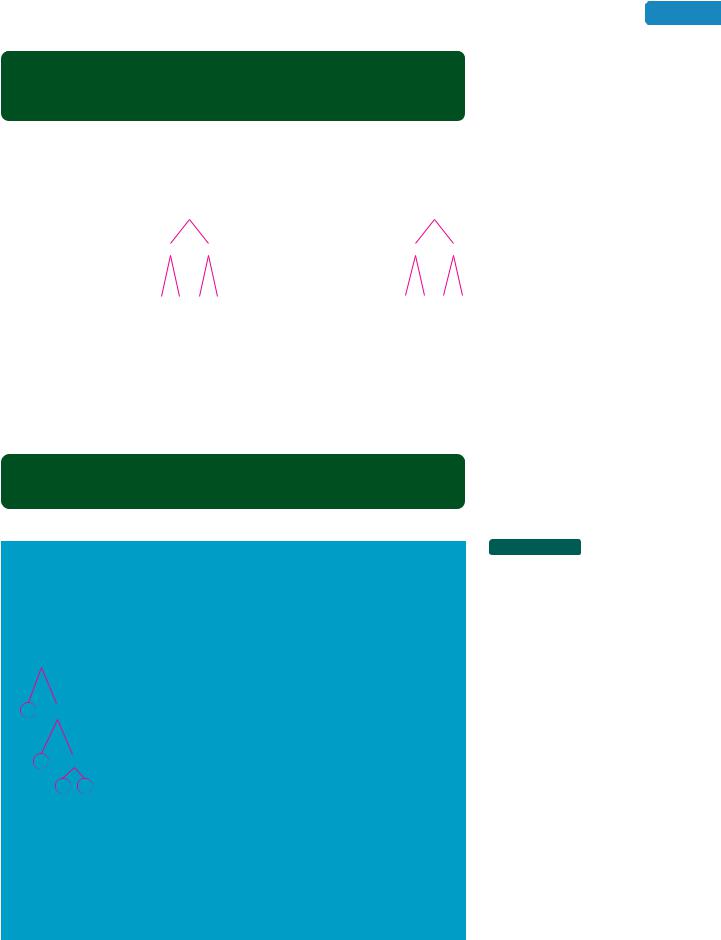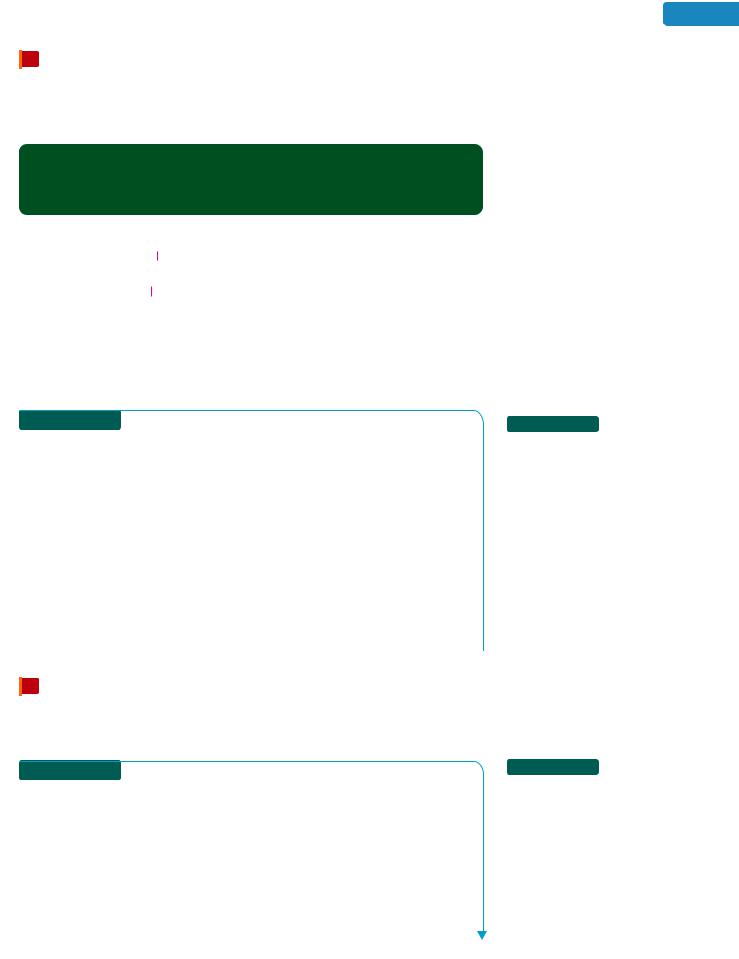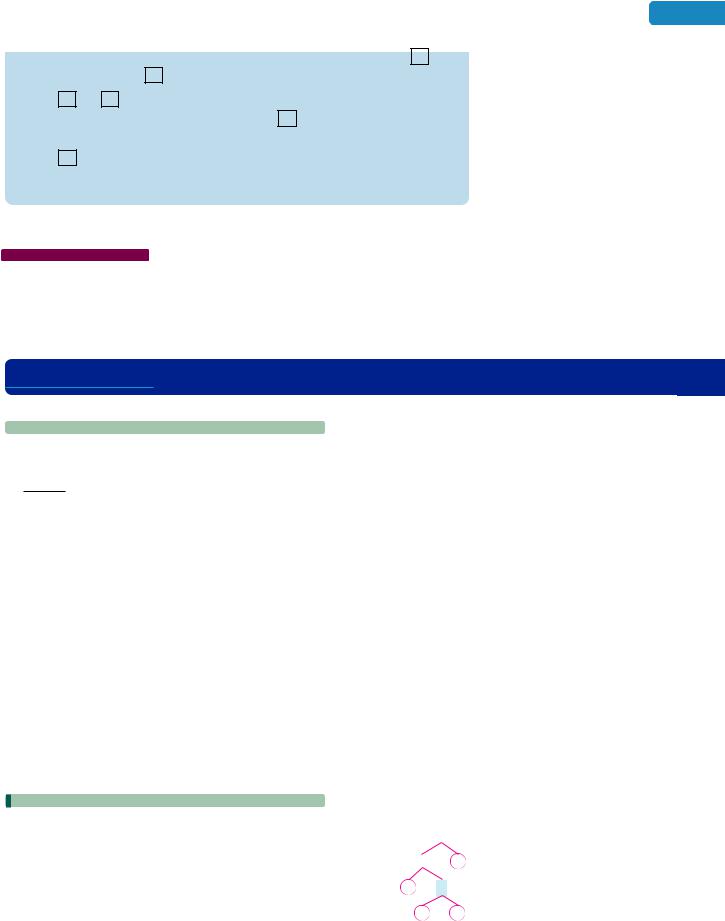
- •Study Skills Workshop
- •1.1 An Introduction to the Whole Numbers
- •1.2 Adding Whole Numbers
- •1.3 Subtracting Whole Numbers
- •1.4 Multiplying Whole Numbers
- •1.5 Dividing Whole Numbers
- •1.6 Problem Solving
- •1.7 Prime Factors and Exponents
- •1.8 The Least Common Multiple and the Greatest Common Factor
- •1.9 Order of Operations
- •THINK IT THROUGH Education Pays
- •2.1 An Introduction to the Integers
- •THINK IT THROUGH Credit Card Debt
- •2.2 Adding Integers
- •THINK IT THROUGH Cash Flow
- •2.3 Subtracting Integers
- •2.4 Multiplying Integers
- •2.5 Dividing Integers
- •2.6 Order of Operations and Estimation
- •Cumulative Review
- •3.1 An Introduction to Fractions
- •3.2 Multiplying Fractions
- •3.3 Dividing Fractions
- •3.4 Adding and Subtracting Fractions
- •THINK IT THROUGH Budgets
- •3.5 Multiplying and Dividing Mixed Numbers
- •3.6 Adding and Subtracting Mixed Numbers
- •THINK IT THROUGH
- •3.7 Order of Operations and Complex Fractions
- •Cumulative Review
- •4.1 An Introduction to Decimals
- •4.2 Adding and Subtracting Decimals
- •4.3 Multiplying Decimals
- •THINK IT THROUGH Overtime
- •4.4 Dividing Decimals
- •THINK IT THROUGH GPA
- •4.5 Fractions and Decimals
- •4.6 Square Roots
- •Cumulative Review
- •5.1 Ratios
- •5.2 Proportions
- •5.3 American Units of Measurement
- •5.4 Metric Units of Measurement
- •5.5 Converting between American and Metric Units
- •Cumulative Review
- •6.2 Solving Percent Problems Using Percent Equations and Proportions
- •6.3 Applications of Percent
- •6.4 Estimation with Percent
- •6.5 Interest
- •Cumulative Review
- •7.1 Reading Graphs and Tables
- •THINK IT THROUGH The Value of an Education
- •Cumulative Review
- •8.1 The Language of Algebra
- •8.2 Simplifying Algebraic Expressions
- •8.3 Solving Equations Using Properties of Equality
- •8.4 More about Solving Equations
- •8.5 Using Equations to Solve Application Problems
- •8.6 Multiplication Rules for Exponents
- •Cumulative Review
- •9.1 Basic Geometric Figures; Angles
- •9.2 Parallel and Perpendicular Lines
- •9.3 Triangles
- •9.4 The Pythagorean Theorem
- •9.5 Congruent Triangles and Similar Triangles
- •9.6 Quadrilaterals and Other Polygons
- •9.7 Perimeters and Areas of Polygons
- •THINK IT THROUGH Dorm Rooms
- •9.8 Circles
- •9.9 Volume
- •Cumulative Review

80 Chapter 1 Whole Numbers
Objectives |
S E C T I O N 1.7 |
1Factor whole numbers.
2Identify even and odd whole numbers, prime numbers, and composite numbers.
3Find prime factorizations using a factor tree.
4Find prime factorizations using a division ladder.
5Use exponential notation.
6Evaluate exponential expressions.
Prime Factors and Exponents
In this section, we will discuss how to express whole numbers in factored form. The procedures used to find the factored form of a whole number involve multiplication and division.
1 Factor whole numbers.
The statement 3 2 6 has two parts: the numbers that are being multiplied and the answer. The numbers that are being multiplied are called factors, and the answer is the product. We say that 3 and 2 are factors of 6.
Factors
Numbers that are multiplied together are called factors.
 Self Check 1
Self Check 1
Find the factors of 20.
Now Try Problems 21 and 27
EXAMPLE 1 Find the factors of 12.
Strategy We will find all the pairs of whole numbers whose product is 12.
WHY Each of the numbers in those pairs is a factor of 12.
Solution
The pairs of whole numbers whose product is 12 are:
1 12 12, 2 6 12, and 3 4 12
In order, from least to greatest, the factors of 12 are 1, 2, 3, 4, 6, and 12.
Success Tip In Example 1, once we determine the pair 1 and 12 are factors of 12, any remaining factors must be between 1 and 12. Once we determine that the pair 2 and 6 are factors of 12, any remaining factors must be between 2 and 6. Once we determine that the pair 3 and 4 are factors of 12, any remaining factors of 12 must be between 3 and 4. Since there are no whole numbers between 3 and 4, we know that all the possible factors of 12 have been
found.
In Example 1, we found that 1, 2, 3, 4, 6, and 12 are the factors of 12. Notice that each of the factors divides 12 exactly, leaving a remainder of 0.
12 |
12 |
12 |
6 |
12 |
4 |
12 |
3 |
12 |
2 |
12 |
1 |
1 |
2 |
3 |
4 |
6 |
12 |
In general, if a whole number is a factor of a given number, it also divides the given number exactly.
When we say that 3 is a factor of 6, we are using the word factor as a noun. The word factor is also used as a verb.
Factoring a Whole Number
To factor a whole number means to express it as the product of other whole numbers.

Factor 40 using: a. two factors b. three factors
Strategy We will find a pair of whole numbers whose product is 40 and three whole numbers whose product is 40.
WHY To factor a number means to express it as the product of two (or more) numbers.
Solution
a. To factor 40 using two factors, there are several possibilities.
40 1 40, 40 2 20, 40 4 10, and 40 5 8
b. To factor 40 using three factors, there are several possibilities. Two of them are:
40 5 4 2 and 40 2 2 10
Find the factors of 17.
Strategy We will find all the pairs of whole numbers whose product is 17.
WHY Each of the numbers in those pairs is a factor of 17.
Solution
The only pair of whole numbers whose product is 17 is: 1 17 17
Therefore, the only factors of 17 are 1 and 17.
1.7 Prime Factors and Exponents |
81 |
 Self Check 2
Self Check 2
Factor 18 using: a. two factors b. three factors
Now Try Problems 39 and 45
 Self Check 3
Self Check 3
Find the factors of 23.
Now Try Problem 49
2Identify even and odd whole numbers, prime numbers, and composite numbers.
A whole number is either even or odd.
Even and Odd Whole Numbers
If a whole number is divisible by 2, it is called an even number.
If a whole number is not divisible by 2, it is called an odd number. The even whole numbers are the numbers
0, 2, 4, 6, 8, 10, 12, 14, 16, 18, p
The odd whole numbers are the numbers 1, 3, 5, 7, 9, 11, 13, 15, 17, 19, p
The three dots at the end of each list shown above indicate that there are infinitely many even and infinitely many odd whole numbers.
The Language of Mathematics The word infinitely is a form of the word infinite, meaning unlimited.
In Example 3, we saw that the only factors of 17 are 1 and 17. Numbers that have only two factors, 1 and the number itself, are called prime numbers.

82 |
Chapter 1 Whole Numbers |
Prime Numbers
A prime number is a whole number greater than 1 that has only 1 and itself as factors.
The prime numbers are the numbers:
2, 3, 5, 7, 11, 13, 17, 19, 23, 29, 31, 37, 41, 43, 47, 53, 59, 61, 67, 71, 73, 79, 83, 89, 97, 101, p
There are infinitely many prime numbers.
Note that the only even prime number is 2. Any other even whole number is divisible by 2, and thus has 2 as a factor, in addition to 1 and itself. Also note that not all odd whole numbers are prime numbers. For example, since 15 has factors of 1, 3, 5, and 15, it is not a prime number.
The set of whole numbers contains many prime numbers. It also contains many numbers that are not prime.
Composite Numbers
The composite numbers are whole numbers greater than 1 that are not prime.
The composite numbers are the numbers
4, 6, 8, 9, 10, 12, 14, 15, 16, 18, p
There are infinitely many composite numbers.
Caution! The numbers 0 and 1 are neither prime nor composite, because neither is a whole number greater than 1.
 Self Check 4
Self Check 4
a.Is 39 a prime number?
b.Is 57 a prime number?
Now Try Problems 53 and 57
|
EXAMPLE 4 |
a. Is 37 a prime number? b. Is 45 a prime number? |
Strategy We will determine whether the given number has only 1 and itself as factors.
WHY If that is the case, it is a prime number.
Solution
a.Since 37 is a whole number greater than 1 and its only factors are 1 and 37, it is prime. Since 37 is not divisible by 2, we say it is an odd prime number.
b.The factors of 45 are 1, 3, 5, 9, 15, and 45. Since it has factors other than 1 and 45, 45 is not prime. It is an odd composite number.
3 Find prime factorizations using a factor tree.
Every composite number can be formed by multiplying a specific combination of prime numbers. The process of finding that combination is called prime factorization.

1.7 Prime Factors and Exponents |
83 |
Prime Factorization
To find the prime factorization of a whole number means to write it as the product of only prime numbers.
One method for finding the prime factorization of a number is called a factor tree. The factor trees shown below are used to find the prime factorization of 90 in two ways.
1. Factor 90 as 9 10. |
90 |
2.Neither 9 nor 10 are
prime, so we factor |
9 |
10 |
each of them. |
|
|
3. The process is |
|
complete when |
3 3 2 5 |
only prime numbers appear at the bottom of all branches.
1. Factor 90 as 6 15. |
90 |
2.Neither 6 nor 15 are
prime, so we factor |
6 |
15 |
each of them. |
|
|
3. The process is |
|
complete when |
2 3 3 5 |
only prime numbers appear at the bottom of all branches.
Either way, the prime factorization of 90 contains one factor of 2, two factors of 3, and one factor of 5. Writing the factors in order, from least to greatest, the primefactored form of 90 is 2 3 3 5. It is true that no other combination of prime factors will produce 90. This example illustrates an important fact about composite numbers.
Fundamental Theorem of Arithmetic
Any composite number has exactly one set of prime factors.
EXAMPLE 5 Use a factor tree to find the prime factorization of 210.
Strategy We will factor each number that we encounter as a product of two whole numbers (other than 1 and itself) until all the factors involved are prime.
WHY The prime factorization of a whole number contains only prime numbers.
Solution
210Factor 210 as 7 30. (The resulting prime factorization will be the same no matter which two factors of 210 you begin with.) Since 7 is prime, circle it. That branch of the tree is completed.
730 Since 30 is not prime, factor it as 5 6. (The resulting prime factorization will be the same no matter which two factors of 30 you use.) Since 5 is prime, circle it. That branch of the tree is completed.
5 |
6 |
Since 6 is not prime, factor it as 2 3. Since 2 and 3 are prime, circle |
|
2 |
them. All the branches of the tree are now completed. |
|
3 |
The prime factorization of 210 is 7 5 2 3. Writing the prime factors in order, from least to greatest, we have 210 2 3 5 7.
Check: Multiply the prime factors. The product should be 210.
2 3 5 7 6 5 7 Write the multiplication in horizontal form.
Working left to right, multiply 2 and 3.
30 7 Working left to right, multiply 6 and 5.
210 |
Multiply 30 and 7. The result checks. |
|
 Self Check 5
Self Check 5
Use a factor tree to find the prime factorization of 126.
Now Try Problems 61 and 71

84 |
Chapter 1 Whole Numbers |
Caution! Remember that there is a difference between the factors and the prime factors of a number. For example,
The factors of 15 are: 1, 3, 5, 15
The prime factors of 15 are: 3 5
 Self Check 6
Self Check 6
Use a division ladder to find the prime factorization of 108.
Now Try Problems 63 and 73
4 Find prime factorizations using a division ladder.
We can also find the prime factorization of a whole number using an inverted division process called a division ladder. It is called that because of the vertical “steps” that it produces.
Success Tip The divisibility rules found in Section 1.5 are helpful when using the division ladder method. You may want to review them at this time.
EXAMPLE 6 Use a division ladder to find the prime factorization of 280.
Strategy We will perform repeated divisions by prime numbers until the final quotient is itself a prime number.
WHY If a prime number is a factor of 280, it will divide 280 exactly.
Solution
It is helpful to begin with the smallest prime, 2, as the first trial divisor. Then, if necessary, try the primes 3, 5, 7, 11, 13, p in that order.
Step 1 The prime number 2 divides 280 exactly. |
2 280 |
|
|
|
|
The result is 140, which is not prime. Continue the division |
140 |
|
|
|
|
|
|
|
|
|
|
process. |
|
|
|
|
|
Step 2 Since 140 is even, divide by 2 again. |
2 280 |
|
|
|
|
The result is 70, which is not prime. Continue the division |
2 140 |
|
|
|
|
70 |
|
|
|
||
process. |
|
|
|
||
|
|
|
|
|
|
Step 3 Since 70 is even, divide by 2 a third time. The result |
2 280 |
|
|
|
|
is 35, which is not prime. |
2 140 |
|
|
|
|
Continue the division process. |
2 70 |
|
|
|
|
|
35 |
|
|
|
|
|
|
|
|
||
Step 4 Since neither the prime number 2 nor the next greatest |
2 280 |
|
|
|
|
prime number 3 divide 35 exactly, we try 5. The result is 7, which |
2 140 |
|
|
|
|
is prime. We are done. |
2 70 |
|
|
|
|
|
|
|
|
|
|
The prime factorization of 280 appears in the left column of the |
5 35 |
|
|
|
|
division ladder: 2 2 2 5 7. Check this result using |
|
7 |
|
|
Prime |
multiplication.
Caution! In Example 6, it would be incorrect to begin the division process with
4280
70
because 4 is not a prime number.

1.7 Prime Factors and Exponents |
85 |
5 Use exponential notation.
In Example 6, we saw that the prime factorization of 280 is 2 2 2 5 7. Because this factorization has three factors of 2, we call 2 a repeated factor. We can use exponential notation to write 2 2 2 in a more compact form.
Exponent and Base
An exponent is used to indicate repeated multiplication. It tells how many times the base is used as a factor.
The exponent is 3.
|
|
|
2 2 2 |
23 |
Read 23 as “2 to the third power” or “2 cubed.” |
⎪ ⎬ ⎪ ⎫ |
|
|
Repeated factors |
The base is 2. |
|
The prime factorization of 280 can be written using exponents: 2 2 2 5 7 23 5 7.
In the exponential expression 23, the number 2 is the base and 3 is the exponent. The expression itself is called a power of 2.
|
EXAMPLE 7 |
Write each product using exponents: |
|
a. 5 5 5 5 |
b. 7 7 11 |
c. 2(2)(2)(2)(3)(3)(3) |
|
Strategy We will determine the number of repeated factors in each expression.
WHY An exponent can be used to represent repeated multiplication.
Solution
a.The factor 5 is repeated 4 times. We can represent this repeated multiplication with an exponential expression having a base of 5 and an exponent of 4:
5 5 5 5 54
b. 7 7 11 72 11 |
7 is used as a factor 2 times. |
|
c. 2(2)(2)(2)(3)(3)(3) 24(33) |
2 is used as a factor 4 times, and 3 is |
|
|
used as a factor 3 times. |
|
|
|
 Self Check 7
Self Check 7
Write each product using exponents:
a.3 3 7
b.5(5)(7)(7)
c.2 2 2 3 3 5
Now Try Problems 77 and 81
6 Evaluate exponential expressions.
We can use the definition of exponent to evaluate (find the value of) exponential expressions.
|
EXAMPLE 8 |
Evaluate each expression: |
a. 72 b. 25 |
c. 104 d. 61 |
|
Strategy We will rewrite each exponential expression as a product of repeated factors, and then perform the multiplication. This requires that we identify the base and the exponent.
WHY The exponent tells the number of times the base is to be written as a factor.
Solution
 Self Check 8
Self Check 8
Evaluate each expression:
a. |
92 |
b. |
63 |
c. |
34 |
d. |
121 |
Now Try Problem 89
We can write the steps of the solutions in horizontal form.

86 |
Chapter 1 Whole Numbers |
a. |
72 |
7 |
7 |
|
Read 72 as “7 to the second power” or “7 squared.” The base is 7 and |
|
|
|
|
|
|
the exponent is 2. Write the base as a factor 2 times. |
|
|
|
49 |
|
Multiply. |
|
|
b. |
25 |
2 |
2 |
2 |
2 2 |
Read 25 as “2 to the 5th power.” The base is 2 and the |
|
|
|
|
|
|
exponent is 5. Write the base as a factor 5 times. |
|
|
4 |
2 |
2 |
2 |
Multiply, working left to right. |
8 2 2
16 2
32
c. 104 10 10 10 10 Read 104 as “10 to the 4th power.” The base is 10 and
the exponent is 4. Write the base as a factor 4 times.
100 10 10 Multiply, working left to right.
1,000 10
10,000
d.61 6 Read 61 as “6 to the first power.” Write the base 6 once.
Caution! Note that 25 means 2 2 2 2 2. It does not mean 2 5. That is, 25 32 and 2 5 10.
 Self Check 9
Self Check 9
The prime factorization of a number is 2 33 52. What is the number?
Now Try Problems 93 and 97
 EXAMPLE 9 The prime factorization of a number is 23 34 5. What is the number?
EXAMPLE 9 The prime factorization of a number is 23 34 5. What is the number?
Strategy To find the number, we will evaluate each exponential expression and then do the multiplication.
WHY The exponential expressions must be evaluated first.
Solution |
|
|
|
|
81 |
|
|
|
|||
We can write the steps of the solutions in horizontal form. |
|
|
|
8 |
|
23 34 5 8 81 5 |
Evaluate the exponential expressions: |
23 |
8 |
|
648 |
|
|
||||
|
and 34 81. |
|
|
|
2 4 |
648 5 |
Multiply, working left to right. |
|
|
|
648 |
|
|
|
5 |
||
|
|
|
|
|
|
3,240 |
Multiply. |
|
|
|
3,240 |
|
|
||||
|
|
|
|
||
23 34 5 is the prime factorization of 3,240.
Success Tip Calculations that you cannot perform in your head should be shown outside the steps of your solution.
Using Your CALCULATOR The Exponential Key:
Bacteria Growth
At the end of 1 hour, a culture contains two bacteria. Suppose the number of bacteria doubles every hour thereafter. Use exponents to determine how many bacteria the culture will contain after 24 hours.
We can use a table to help model the situation. From the table, we see a pattern developing: The number of bacteria in the culture after 24 hours will be 224.
|
Number of |
|
Time |
bacteria |
|
|
|
|
1 hr |
2 |
21 |
2 hr |
4 |
22 |
3 hr |
8 |
23 |
4 hr |
16 |
24 |
24 hr |
? |
224 |
|
|
|

1.7 Prime Factors and Exponents |
87 |
We can evaluate this exponential expression using the exponential key yx on |
||||||
a scientific calculator 1xy on some models2. |
|
|
|
|
||
2 yx 24 |
|
|
|
|
||
|
|
16777216 |
|
|||
On a graphing calculator, we use the carat key |
¿ |
to raise a number to a |
||||
power. |
|
|
|
|
||
|
|
|
|
|
|
|
2 ¿ 24 |
ENTER |
|
|
|
16777216 |
|
Since 224 16,777,216, there will be 16,777,216 bacteria after 24 hours.
|
ANSWERS TO SELF CHECKS |
|
|
|
|
|
|
|
|||
|
|
|
|
|
|
|
|
||||
|
1. |
1, 2, 4, 5, 10, and 20 |
2. |
a. |
1 |
18, 2 9, or 3 6 |
b. Two possibilities are 2 3 3 and |
||||
|
1 2 9 |
3. 1 and 23 |
4. a. no |
|
b. no 5. |
2 3 3 7 |
6. 2 2 3 3 3 7. a. 32 7 |
||||
|
b. |
52(72) |
c. 23 32 5 |
8. |
a. |
81 |
b. 216 |
c. 81 |
d. 12 |
9. 1,350 |
|
|
|
|
|
|
|
|
|
|
|
|
|
S E C T I O N 1.7 STUDY SET
 VOCABULARY
VOCABULARY
Fill in the blanks.
1. Numbers that are multiplied together are called
.
2. |
To |
|
|
|
|
|
a whole number means to express it as the |
||||||||||||
|
product of other whole numbers. |
||||||||||||||||||
3. |
A |
|
|
|
|
number is a whole number greater than 1 |
|||||||||||||
|
that has only 1 and itself as factors. |
||||||||||||||||||
4. |
Whole numbers greater than 1 that are not prime |
||||||||||||||||||
|
numbers are called |
|
|
|
numbers. |
||||||||||||||
5. |
To prime factor a number means to write it as a |
||||||||||||||||||
|
product of only |
|
numbers. |
||||||||||||||||
6. |
An exponent is used to represent |
|
|
||||||||||||||||
|
multiplication. It tells how many times the |
||||||||||||||||||
|
used as a factor. |
|
|
|
|
|
|
|
|||||||||||
7. |
In the exponential expression 64, the number 6 is the |
||||||||||||||||||
|
|
|
|
|
, and 4 is the |
|
|
. |
|
|
|
|
|
||||||
8. |
We can read 52 as “5 to the second power” or as “5 |
||||||||||||||||||
|
|
|
|
|
|
.” We can read 73 as “7 to the third power” or |
|||||||||||||
|
as “7 |
|
|
|
|
|
.” |
|
|
|
|
|
|
|
|||||
9.Fill in the blanks to find the pairs of whole numbers whose product is 45.
1  45 3
45 3  45 5
45 5  45
45
The factors of 45, in order from least to greatest, are:  ,
,  ,
,  ,
,  ,
,  ,
, 
10.Fill in the blanks to find the pairs of whole numbers whose product is 28.
1  28 2
28 2  28 4
28 4  28
28
The factors of 28, in order from least to greatest, are:  ,
,  ,
,  ,
,  ,
,  ,
, 
11.If 4 is a factor of a whole number, will 4 divide the number exactly?
12.Suppose a number is divisible by 10. Is 10 a factor of the number?
13.a. Fill in the blanks: If a whole number is divisible by
2, it is an |
|
|
number. If it is not divisible by 2, it |
|
is an |
|
number. |
||
b.List the first 10 even whole numbers.
c.List the first 10 odd whole numbers.
14.a. List the first 10 prime numbers.
b.List the first 10 composite numbers.
15.Fill in the blanks to prime factor 150 using a factor tree.
150
30
5
3
The prime factorization of 150 is 


 .
.

88Chapter 1 Whole Numbers
16.Which of the whole numbers, 1, 2, 3, 4, 5, 6, 7, 8, 9, and 10, could be at the top of this factor tree?
|
? |
Prime |
Prime |
number |
number |
17.Fill in the blanks to prime factor 150 using a division ladder.
 150 3 75
150 3 75
5 
5
The prime factorization of 150 is 


 .
.
18.a. When using the division ladder method to find the prime factorization of a number, what is the first divisor to try?
b.If 2 does not divide the given number exactly, what other divisors should be tried?
 NOTATION
NOTATION
19.For each exponential expression, what is the base and the exponent?
a. 76 |
b. 151 |
20.Consider the expression 2 2 2 3 3.
a.How many repeated factors of 2 are there?
b.How many repeated factors of 3 are there?
 GUIDED PRACTICE
GUIDED PRACTICE
Find the factors of each whole number. List them from least to greatest. See Example 1.
21. |
10 |
22. |
6 |
23. |
40 |
24. |
75 |
25. |
18 |
26. |
32 |
27. |
44 |
28. |
65 |
29. |
77 |
30. |
81 |
31. |
100 |
32. |
441 |
Factor each of the following whole numbers using two factors.
Do not use the factor 1 in your answer. See Example 2.
33. |
8 |
34. |
9 |
35. |
27 |
36. |
35 |
37. |
49 |
38. |
25 |
39. |
20 |
40. |
16 |
Factor each of the following whole numbers using three factors.
Do not use the factor 1 in your answer. See Example 2
41. |
30 |
42. |
28 |
43. |
63 |
44. |
50 |
45. |
54 |
46. |
56 |
47. |
60 |
48. |
64 |
Find the factors of each whole number. See Example 3.
49. |
11 |
50. |
29 |
51. |
37 |
52. |
41 |
Determine whether each of the following numbers is a prime number. See Example 4.
53. |
17 |
54. |
59 |
55. |
99 |
56. |
27 |
57. |
51 |
58. |
91 |
59. |
43 |
60. |
83 |
Find the prime factorization of each number. Use exponents in your answer, when it is helpful. See Examples 5 and 6.
61. |
30 |
62. |
20 |
63. |
39 |
64. |
105 |
65. |
99 |
66. |
400 |
67. |
162 |
68. |
98 |
69. |
64 |
70. |
243 |
71. |
147 |
72. |
140 |
73. |
220 |
74. |
385 |
75. |
102 |
76. |
114 |
Write each product using exponents. See Example 7.
77. |
2 |
2 2 |
2 2 |
78. |
3 3 |
3 3 3 3 |
79. |
5 |
5 5 |
5 |
80. |
9 9 |
9 |
81. |
4(4)(8)(8)(8) |
82. |
12(12)(12)(16) |
|||
83.7 7 7 9 9 7 7 7 7
84.6 6 6 5 5 6 6 6
Evaluate each exponential expression. See Example 8. |
|
||||||||
85. |
a. |
34 |
b. |
43 |
86. |
a. |
53 |
b. |
35 |
87. |
a. |
25 |
b. |
52 |
88. |
a. |
45 |
b. |
54 |
89. |
a. |
73 |
b. |
37 |
90. |
a. |
82 |
b. |
28 |
91. |
a. |
91 |
b. |
19 |
92. |
a. |
201 |
b. |
120 |
